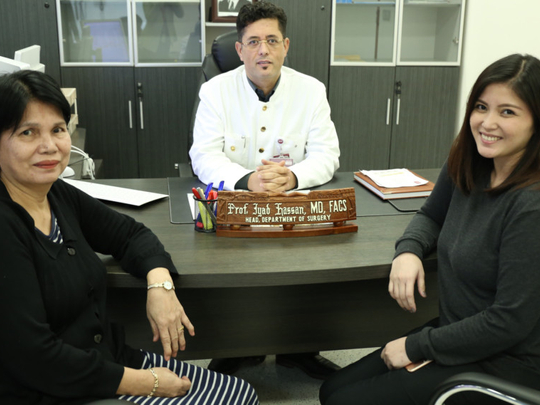
Dubai: In a complex and rare surgery, oncology surgeon of Burjeel Hospital, Abu Dhabi, saved the life of a young Filipino patient from a high-risk cancerous pancreatic tumour.
The four-centimetre tumour that occurred at the head of the pancreas was excised in an over four-hour surgery known as the Whipple procedure that is well known around the world but rare in this region.
Early this month, 27-year-old banker Marris Hernandez accidentally discovered that she had a neuro-endocrine cancer of the pancreatic head.
Hernandez told Gulf News: “At first I felt pain in my lower abdomen, so I immediately visited a private hospital in Abu Dhabi. An ultrasound could not detect anything but gall stones. But a series of additional tests helped discover the tumour.”
Hernandez was admitted to the hospital to remove the stones that may cause jaundice. At the same time, some part of the tumour was taken for examination.
“I didn’t feel too well after the procedure and felt bloated and vomited too, later it was confirmed the tumour could only be removed through a complex open surgery,” recalled Hernandez.
Dr Iyad Hassan, chair surgery and director of the Endocrine Cancer Surgery at Burjeel, who led the team, told Gulf News: “Hernandez’ case was very serious especially because this is an extremely rare cancer, usually found in people of an older age. The cancer is also hard to diagnose as it presents with symptoms usually associated with kidney stones,” he explained.
He added: “This is definitely the first of such operative procedure for big neuro-endocrine tumour of the pancreatic head surrounding the most important vessels of the liver and small intestine in this part of the world. The surgery has certainly widened the scope of endocrine surgical oncology procedure to treat similar complex endocrine cancer cases.”
Hernandez who has recovered is very happy that she decided to undergo the surgery in the UAE. “When I learnt about my condition, I discussed it immediately with my relatives. They advised me to take a second opinion, so I went to Burjeel Hospital and consulted Prof Dr Hassan,” she said.
Hernandez decided to have the surgery under Dr Hassan. “The moment I told my family back home, they were very worried. They even asked me to return to Manila for surgery. But I had complete faith in Dr Hassan’s expertise, and am happy I took this decision,” said a beaming Hernandez.
The international benchmarks average five-eight hours to complete a Whipple procedure, but this case took only four-and-a-half hours to remove the 4cm tumour. Hernandez recovered well after the surgery and was discharged after 10 days. She, however, requires special injections every three months to stay healthy and keep the cancer at bay.
“I am very grateful for the efforts taken by the medical team at Burjeel Hospital. I had almost given up hope after receiving alarming news from the previous hospitals. Dr Hassan and his clinical team were very supportive and caring at every point of the journey. Words cannot express my appreciation for this second chance at life,” said Hernandez who has been able to resume work since then.
All about Whipple surgery
The Whipple procedure continues to be one of the most demanding and risky techniques, so the American Cancer Society recommends consulting specialised hospitals that perform frequent pancreatic surgeries.
In a standard Whipple procedure, the surgeon removes the head of the pancreas, the gallbladder, part of the duodenum which is the uppermost portion of the small intestine, a small portion of the stomach called the pylorus, and the lymph nodes near the head of the pancreas. The surgeon then reconnects the remaining pancreas and digestive organs so that pancreatic digestive enzymes, bile, and stomach contents flow into the small intestine during digestion. The Whipple procedure can take several hours to perform and requires great surgical skill and experience. The area around the pancreas is complex and surgeons are often challenged by variation in the arrangement of blood vessels and ducts.
When the Whipple procedure was introduced, surgeons were hesitant to utilise the technique due to high mortality rate. In the 1970s, up to 25 per cent of cases failed during the surgery or shortly thereafter. Since then, improvements in diagnosis, staging, surgical techniques, anaesthesia, and post-operative care have reduced the short-term death rate to less than 4 per cent in large hospitals with experienced surgeons. But mortality rate can still go above 15 per cent if treated at small hospitals or by less experienced surgeons.












